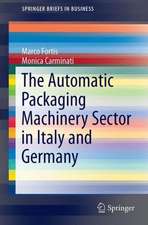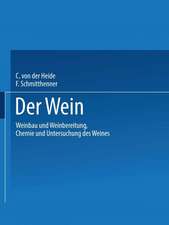The Packaging User’s Handbook
Autor Frank A. Paineen Limba Engleză Hardback – 30 oct 1990
| Toate formatele și edițiile | Preț | Express |
|---|---|---|
| Paperback (1) | 1239.05 lei 43-57 zile | |
| Springer Us – 16 mar 2012 | 1239.05 lei 43-57 zile | |
| Hardback (1) | 1238.42 lei 43-57 zile | |
| Springer Us – 30 oct 1990 | 1238.42 lei 43-57 zile |
Preț: 1238.42 lei
Preț vechi: 1510.27 lei
-18% Nou
Puncte Express: 1858
Preț estimativ în valută:
236.97€ • 248.04$ • 197.24£
236.97€ • 248.04$ • 197.24£
Carte tipărită la comandă
Livrare economică 31 martie-14 aprilie
Preluare comenzi: 021 569.72.76
Specificații
ISBN-13: 9780751401516
ISBN-10: 075140151X
Pagini: 596
Ilustrații: XVIII, 596 p.
Dimensiuni: 178 x 254 x 33 mm
Greutate: 1.04 kg
Ediția:1991
Editura: Springer Us
Colecția Springer
Locul publicării:New York, NY, United States
ISBN-10: 075140151X
Pagini: 596
Ilustrații: XVIII, 596 p.
Dimensiuni: 178 x 254 x 33 mm
Greutate: 1.04 kg
Ediția:1991
Editura: Springer Us
Colecția Springer
Locul publicării:New York, NY, United States
Public țintă
ResearchDescriere
The first version of this book, Packaging Materials and Containers was published in 1967 and was revised extensively ten years later under the title The Packaging Media. Some thirty or so authors were involved in producing the initial texts for these books, and I must acknowledge their material, much of which is still valid. It is now thirteen years since The Packaging Media-high time to take stock and incorporate the considerable advances in materials, forms, techniques and machinery that have taken place. In 1977, wherever possible, we asked the original authors to carry out the revisions, but retirements and job changes have now eliminated over twenty of the original authors. We have therefore appointed an Editorial Board to advise on this more extensive revision, and I wish to thank them for their detailed and helpful assistance: Dr C. J. Mackson and Professor Y. Dagel for general comments and guidance on the overall plan and, in particular, the Introduction (chapter 1); Graham Gordon and Harri Mostyn for assistance with much of Part D on Distribution Packages, and Dennis Hine and Susan Selke for their work in respect of paperboard and plastics retail packaging, respectively. A major contribution was made by the seventh member of the Editorial Board, David Osborne, who advised in the area of glass.
Cuprins
A Introduction.- 1 Introduction.- Package functions.- Packaging material usage.- Packaging costs.- Shipping containers.- Retail packaging.- Packaging and the environment.- Energy considerations.- Material resources.- Recycling of packaging materials.- B Packaging Materials.- 2 Wood and wood-based materials.- From tree to merchant.- The nature of wood.- Woods for box-making.- Defects in wood.- Plywood.- Fibre building boards.- Board types and manufacture.- Processing and use techniques.- 3 Pulps and papers.- Materials.- Non-fibrous additives.- What is wood?.- Pulping processes.- Beating.- Paper-making machines.- Stuff chest.- Head box.- Slice.- Fourdrinier wire.- Presses.- Dryers.- MG dryer.- Calender stacks.- Main packaging papers.- Unconverted papers.- Wrapping papers.- Interleaving.- Stiffening and supporting.- Shock absorption and space filling.- Papers for conversion.- Performance requirements.- Physical properties.- Chemical properties.- Types of wrapping material available.- Storage of materials.- 4 Paperboard.- Terminology.- Structure and general properties.- Some definitions.- Physical characteristics.- Mechanical properties.- Surface properties.- Optical properties.- Board making.- Fourdrinier machines.- Cylinder mould or vat machines.- Roll formers.- Multi-ply board machines.- Finishing processes.- Other surface treatments.- Folding boxboards.- Boards for rigid boxes.- Fibreboards for shipping containers.- Solid fibreboard.- Corrugated fibreboard.- Manufacture of corrugated board.- 5 Metal packaging.- Blackplate.- Tin-free steel.- Recycling.- Aluminium.- Foil.- Corrosion of tinplate.- Mechanism of corrosion.- Polarization.- Stress corrosion.- Presence of inhibitors.- Passivity.- Corrosion testing.- Lacquer coatings.- 6 Glass.- The nature of glass.- Plant overview.- Receiving raw materials.- Charging.- Melting.- The furnace.- 7 Plastics.- Raw materials.- Plastics based on natural polymers.- Polysaccharides.- Proteins.- Rubber.- Plastics based on synthetic polymers.- Thermosets.- Thermoplastics.- 8 Adhesives.- Historical.- Definitions.- Setting time/open time/tack.- Principles of adhesion.- Mechanisms of adhesion.- Requirements of good bond strength.- Classification of adhesives.- Notes on adhesives.- Water-based adhesive systems.- Solvent-based adhesives.- Hot melt adhesives.- Adhesive applicators.- Cold adhesive systems.- Hot-melt systems.- C Retail Packaging.- 9 Packaging with flexible barriers.- Styles of wrapping.- Hand-wrapping.- Assisted hand-wrapping.- Bagging.- Mechanical wrapping.- The wares to be packed.- General.- Dry wares.- Moist wares.- ‘Breathing’ wares.- Meats.- Liquids.- Incidental processes.- Preforming.- Shrink wrapping.- Vacuum packing.- Gas packing.- 10 Folding boxboard cartons.- Definitions.- Materials.- Manufacture.- Preliminary stage.- Production stage.- Printing.- The cutting and creasing operation.- Stripping.- Finishing.- Erection, filling and closure of cartons.- Packaging by hand.- Mechanized packaging with carton blanks.- Mechanized packaging with side seam glued cartons.- Cartons for solid products.- Cartons for liquid products.- Common carton styles and their uses.- Special constructions.- Advantages of carton systems.- Factors to be considered in a cartoning development project.- Product factors.- Machinery considerations.- Marketing considerations.- General considerations.- Carton specification and quality control.- 11 Rigid and cylindrical boxes and composite containers.- Rigid boxes.- Markets.- Materials.- Manufacturing stages.- Problems of rigid boxmaking.- The rigid box as a package.- Rigid plastic boxes.- Cylindrical boxes and composite containers.- Manufacturing processes.- Body and functional barrier materials.- Body materials.- Lining materials.- Other barriers.- Types of closure.- Usage.- Other constructions.- Composite or metal container?—the choice.- Basic cost factors.- Measurement of composite containers.- 12 Metal cans.- Historical background.- The built-up construction.- Treatment of can seams.- End double seams.- Interlocked side seam.- Other types of seams and joints.- End seams.- Cans without side seams.- The drawn and wall-ironed can.- Solid-drawn containers.- The round vacuum tin.- Manufacturing limitations of deep-drawn tins.- Limitations of drawing round tins.- Limitations of drawing rectangular tins.- General-line built-up tins.- The slip-lid tin.- The lever-lid tin.- Oblong pourer tins.- An in-between method: the locked-corner tin.- Economics.- The ideal geometry.- Getting the most out of available material.- Measuring and describing tins.- Closures.- The once-only closure.- The re-closable closure.- Decoration of cans and tins.- Offset lithography.- Dry offset printing.- Silk screen printing.- Paper labelling.- 13 Aerosols (pressurized containers).- Historical development.- Definitions.- Types of pressurized packages.- Components.- Caps.- Valves.- Containers.- Propellants.- Products.- Labels.- Filling.- Cold filling.- Pressure filling.- Non-chemical sprayers.- 14 Metal and plastic collapsible tubes and aluminium foil containers.- General description.- Methods of production.- Mechanical fabrication.- Treatment of the surfaces.- Collapsible plastic tubes.- Laminated tubes.- Types and styles of container.- Sealing.- Types of closure and methods of closing.- Packing and dispatch.- Aluminium foil containers.- Manufacture.- Use in microwave ovens.- 15 Glass containers.- Tubular containers.- Glass container making.- Forming the container.- Semi-automatic process.- Annealing.- Inspection.- Quality control.- Acceptance sampling.- Tests and test procedures.- Capacity.- Specifications.- Packaging.- Design.- Stress analysis.- Decoration.- Developments.- Reduction of surface damage.- Current approaches to conserving or improving container strength.- Surface treatment.- 16 Moulded pulp, expanded polystyrene, moulded and thermoformed plastic containers.- Moulded pulp containers.- Manufacture.- Typical uses.- Choice of manufacturing process.- Moulded plastic containers.- Definitions.- Methods of production.- Types and styles of container.- Types of closure.- Uses of moulded plastic containers.- The development of the PET bottle.- Beverages.- Enhanced PET containers.- Use of newer materials for containers.- Developments in container manufacture.- 17 Closures and dispensing devices for glass and plastic containers.- The general requirements for a good seal.- The mechanics of a good seal.- The importance of thread engagement and thread pitch.- Applying the correct tightening torque to screw caps.- The importance of vacuity or ullage.- Types of closures.- Selection of closures.- Normal seals.- Vacuum-tight seals.- Pressure-tight seals.- Secondary functions of closures.- Inviolability.- Non-refillability.- Dispensing, measuring and pouring devices.- Child resistance.- Sales appeal.- The manufacture of closures.- Metal caps.- Moulded caps made from thermosetting plastics.- Moulded caps made from thermoplastic plastics.- Choosing the right type of closure.- Liners.- Compatibility between closures and the contents of containers.- Facing materials.- Closure design.- Methods of application of closures.- Sealing methods.- Combination closures.- 18 Decoration of packaging.- Printing processes.- Relief printing.- Intaglio printing.- Planographic printing.- Screen printing.- Ink-jet printing.- Labels and labelling.- Types of labels.- Heat transfer labelling.- In-mould labelling.- Shrink sleeve decoration.- Materials for labels.- Label forms and shapes.- Adhesion of labels.- Labelling machinery and equipment.- Purchasing, installation and operation of labelling machinery.- Minimization of labelling faults and problems.- Correction of labelling faults.- D Distribution Packages.- 19 Cylindrical shipping packages.- Wooden casks and plywood kegs.- Wet and dry cooperage.- Plywood barrels.- Production methods.- Types and styles of container.- Types of closure and methods of closing.- Drums.- Metal drums.- Fibre drums.- Plastic drums and composites.- 20 Rectangular shipping containers.- Timber and Plywood Cases and Crates.- Basic types.- Nailed wooden boxes.- Crates.- Wire bound boxes and crates.- Sill and skid-base cases and crates.- Waterproof linings.- Closure of cases.- Corrugated and Solid Fibreboard Cases.- Manufacture of corrugated containers.- Corrugators.- Printer-slotters.- Flexo folder-gluers.- Die-cut cases.- Manufacturer’s joint.- Partition makers.- Manufacture of solid fibreboard cases.- Closures.- Paper, plastics and fabric sealing tapes.- Stapling.- The hazards of transport and the assessment of fibreboard packages.- Uses of corrugated and solid board.- Case styles.- Industry trends.- Automation.- Retail packages.- Competition.- Case quality and quality control.- Packaging applications of hardboard and insulating board.- Plastic Crates.- Materials.- Plastics crates for milk.- Plastics crates for beer and soft drinks.- Plastic crates for agricultural products and foodstuffs.- Intermediate Bulk Containers.- 21 Flexible shipping packages.- Textile Sacks, Bags, Bales and Baling.- Sack manufacture.- Nomenclature.- Finishing treatments.- Mechanical.- Chemical.- Sacks and bags.- Sizes of sacks and bags.- Standardization.- Lined sacks and bags.- Selection of correct size/type of sack.- Methods of closing.- Bales.- Covering.- Forming of the bale.- Compression.- Strapping.- Marking.- Multi-Wall Paper Sacks.- Open-mouth sacks.- Valved sacks.- Valves.- Materials.- Manufacture.- Filling and closing sacks.- Open-mouth sacks.- Valve sacks.- Storage of sacks.- Handling of sacks.- The assessment of paper and sacks.- Present and future use of paper sacks.- Baler bags.- Mailing bags and sacks.- Sacks Made from Plastic Film.- Early developments.- Advantages of plastic sacks for fertilizer.- Other applications for heavy-duty polyethylene sacks.- Heavy-duty polyethylene sacks.- Properties.- Manufacture.- Types of plastic film sack.- Valved plastic film sacks.- Laminated film sacks.- Co-extruded laminated sacks.- Cross-ply laminated sacks.- Sacks of Other Materials.- Woven plastic film tape sacks.- Manufacture.- Liners.- Closure.- Properties.- Applications.- 22 Pallets and unit loads.- Methods of palletization and unitization.- Equipment for handling palletized and unitized loads.- Wooden pallet construction and specification.- Pallet performance.- Load capacity.- Other pallet performance factors.- Forming and securing unit loads.- High level palletizers.- Low level palletizers.- Bulk palletizers.- Robotic palletizers.- Load restraint.- Adhesives.- Strapping.- Enveloping.- Pallet and unit load dimensions.- Pallet utilization.- Economic factors.- Strapping (steel or non-metallic).- Strength.- Adequate elongation.- Hand tools.- Power strapping machines.- Non-metallic strapping.- Elongation and elastic return.- Transmission of tension.- Package conformation.- Moisture resistance.- Types of tools available.- 23 Package cushioning systems.- Nature of the product to be protected.- Properties of cushioning materials.- Dynamic performance.- Fatigue and thickness loss.- Creep.- Moisture content.- Water absorption.- Corrosive effects.- Mould growth.- Dusting.- Space fillers.- Powders and granules.- Wrapping materials.- Shredded materials.- Less resilient materials.- Wood wool.- Expanded polystyrene.- Moulded fittings.- Corrugated fibreboard.- Resilient materials.- Rubberized hairs.- Crimped rubberized hair.- Polyurethane foams (flexible).- Bonded polyurethane chipfoam.- Expanded polyethylene.- Air bubble film.- Corner pieces.- Selection of bulk cushions.- Other factors.- Cushioning devices.- Bonded-rubber shock mounts.- Shear mountings.- Conical mounts.- Metalastik buckling mounts.- Tubular mountings (BTR).- Delta mountings (Silentbloc).- Steel spring systems.- Coil springs.- Leaflote springs.- ‘Pnucush’ mounts (Wilmount packaging).






























